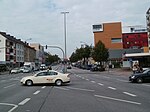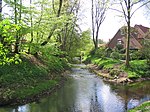Leibniz-Institute of Virology

The Leibniz Institute of Virology was founded in 1948 by Heinrich Pette, a German neurologist. It began as a research facility to create a polio vaccine. It is now a private foundation and involved with basic research in virology and the immune responses of organisms. The institute is a non-profit public beneficiary organisation and an independent member of the Leibniz Association, located in Hamburg. Until 2021, the institute bore the name Heinrich Pette Institute, Leibniz Institute for Experimental Virology. Due to Heinrich Pette's activities in the year 1933-45, the Institute initially decided in 2021 to no longer use Pette's name as part of its institute name in the future. In May 2022, the institute was renamed Leibniz Institute of Virology.
Excerpt from the Wikipedia article Leibniz-Institute of Virology (License: CC BY-SA 3.0, Authors, Images).Leibniz-Institute of Virology
Heinrich-Kock-Weg, Hamburg Lokstedt
Geographical coordinates (GPS) Address Phone number Website Nearby Places Show on map
Geographical coordinates (GPS)
| Latitude | Longitude |
|---|---|
| N 53.5934 ° | E 9.9732 ° |
Address
Universitätsklinikum Eppendorf
Heinrich-Kock-Weg
22529 Hamburg, Lokstedt
Germany
Open on Google Maps







